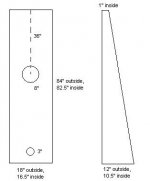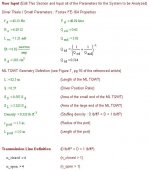This is my first post in this part of diyaudio. (I've been doing a little bit of stuff over in the projector area.) Anyway, I am now looking to build myself some speakers. I would like a set up that I can use for home theater (center, 2 mains, 2 surrounds, possible sub) but that I can also use for listening to music. I do not have a problem doing something somewhat complex, as I am an engineer and have done my fair share of woodworking (probably a few other people's fair share, too 🙂). However, I would like to keep it fairly inexpensive, since I just bought a house and money is a bit short right now. After looking around this site and several others, I was thinking about building a pair of Voigt Pipes for the mains. I believe these are also called TQWT's. It seems that, for the money and effort, these are pretty good, at least for music. This leads to my first question:
1. Would TQWT's work for a surround sound setup as well?
I have seen some formulas for calculating the height of the pipe needed for a given LF response limit. 343 (speed of sound) / (desired LF) = wavelength in meters. The divide that by 4 to get the height of the pipe you need, since it is QW. I am assuming this is right, but if not, let me know.
2. What effect does stuffing the pipe have on the calculated LF response? Does it make it lower, higher, or do nothing at all?
I have also seen some conflicing remarks as to the design of the top of the pipe. According to http://kosat.consultit.no/~ketil/lowther/voigtpip.html, the top should reach a point, but I've also read elsewhere that a zero-area top should be avoided, and that it should be no smaller than Sd. (I think I've figured out Sd is the surface area of the cone on the driver, correct?)
3. What effect does the size of the top of the pipe have?
As far as finding a possible driver, I have found these 2:
http://www.partsexpress.com/pe/show...6&St3=-49401208&DS_ID=3&Product_ID=7458&DID=7
http://support.radioshack.com/support_audio/doc65/65826.pdf
I can get the RS one for $10 each on clearance at my local store.
I have also seen this setup, using 2 drivers:
http://www.partsexpress.com/projectshowcase/pipes/pipes.html
I like the idea of a single driver, even if it isn't quite perfect, because I can easily upgrade to a better driver in the future.
4. Do either of the 2 full-range drivers I listed look OK? Should I keep looking? Or should I try for a 2-driver setup?
The high-end of the 2 full-range drivers I found goes up to 17kHz (Pioneer) and 18kHz (RS). I am not as concerned about the low-end, (36kHz and 40kHz) because I am considering buidling a sub as well.
5. Should I focus on finding a driver with a better high-end response, at the possible expense of low-end? Is buidling a sub redundant if I build the pipes? Will a sub muddle the bass from the pipes?
Obviously, if the answer to #1 is "No," questions 2-5 aren't very applicable. At this point, I have a few other, non-pipe specific questions.
6. Why is plywood considered a better building material than MDF?
7. What should I look for in designing an enclosure/picking a driver(s) for a center channel and surrounds (and possibly a sub)? Can I run a full-range driver, or should I go with a multi-way and crossover? (I think I remember seeing something about crossing the center ~3000Hz, and I'd obviously want a crossover on a sub.) Assuming I can find a good driver for the mains (if a pipe is viable), wouldn't I get a better sound if I used the same driver for the center and surrounds as well?
That's all the questions I have (or can think of) right now. Like I said, I'm new to this and am still learning. Any help/ideas/tips/advice/telling-me-I'm-a-fool-for-this would be appreciated.
1. Would TQWT's work for a surround sound setup as well?
I have seen some formulas for calculating the height of the pipe needed for a given LF response limit. 343 (speed of sound) / (desired LF) = wavelength in meters. The divide that by 4 to get the height of the pipe you need, since it is QW. I am assuming this is right, but if not, let me know.
2. What effect does stuffing the pipe have on the calculated LF response? Does it make it lower, higher, or do nothing at all?
I have also seen some conflicing remarks as to the design of the top of the pipe. According to http://kosat.consultit.no/~ketil/lowther/voigtpip.html, the top should reach a point, but I've also read elsewhere that a zero-area top should be avoided, and that it should be no smaller than Sd. (I think I've figured out Sd is the surface area of the cone on the driver, correct?)
3. What effect does the size of the top of the pipe have?
As far as finding a possible driver, I have found these 2:
http://www.partsexpress.com/pe/show...6&St3=-49401208&DS_ID=3&Product_ID=7458&DID=7
http://support.radioshack.com/support_audio/doc65/65826.pdf
I can get the RS one for $10 each on clearance at my local store.
I have also seen this setup, using 2 drivers:
http://www.partsexpress.com/projectshowcase/pipes/pipes.html
I like the idea of a single driver, even if it isn't quite perfect, because I can easily upgrade to a better driver in the future.
4. Do either of the 2 full-range drivers I listed look OK? Should I keep looking? Or should I try for a 2-driver setup?
The high-end of the 2 full-range drivers I found goes up to 17kHz (Pioneer) and 18kHz (RS). I am not as concerned about the low-end, (36kHz and 40kHz) because I am considering buidling a sub as well.
5. Should I focus on finding a driver with a better high-end response, at the possible expense of low-end? Is buidling a sub redundant if I build the pipes? Will a sub muddle the bass from the pipes?
Obviously, if the answer to #1 is "No," questions 2-5 aren't very applicable. At this point, I have a few other, non-pipe specific questions.
6. Why is plywood considered a better building material than MDF?
7. What should I look for in designing an enclosure/picking a driver(s) for a center channel and surrounds (and possibly a sub)? Can I run a full-range driver, or should I go with a multi-way and crossover? (I think I remember seeing something about crossing the center ~3000Hz, and I'd obviously want a crossover on a sub.) Assuming I can find a good driver for the mains (if a pipe is viable), wouldn't I get a better sound if I used the same driver for the center and surrounds as well?
That's all the questions I have (or can think of) right now. Like I said, I'm new to this and am still learning. Any help/ideas/tips/advice/telling-me-I'm-a-fool-for-this would be appreciated.
🙂 TYPE IN your search engine, yahoo or google, ad infinitum or whatever the following text "BOB BRINES SPEAKER STUFF" and that will give you a handy link to BOb's stuff, full of very interesting things on the very subject of TQWT's and loaded pipes such as you are talking about including his "peerless pipes"which should point the direction out for you that you are seeking cheers TC
cheers TC
 cheers TC
cheers TCThanks for the tips and pointers to the other sites.
At this point, I think I'm going to go with this driver, an 8" Pioneer. I've also spent some time playing with Martin King's MathCad sheets and designing my enclosure. A rough sketch of the enclosure is in one of the attached files. Making a couple of assumptions (more on that later), I've come up with the inputs listed in the inputs file. These gave me the response, shown in the response file. My question is, does this look like it should work? I am also working on changing the layout of the enclosure so that the narrow side is the "front," and not the wide side. I know this reduces So, but it didn't really affect the modelled response, maybe even made it better.
Now, about those assumptions I made. Using the MathCad sheets, I left the section for Transmission Line Definition alone, leaving n_open and n_closed both equal to 4. What exactly do these values change, and should I do something with them? I also assumed that I could mount the driver on the vertical "front" of the triangle, rather than on the "side," as Martin did. Is this correct?
A few other things: How do you determine how much stuffing you need? The worksheet allows you to specify the density, and Martin's sketches/notes say "stuff the top only," but how much is the "top"? A certain percentage of the total height? From a bit below the driver? Also, is there anyway to model the higher frequency response of this driver in this type of enclosure? I'm not sure if this is really necessary. I do know that the driver is only rated up to 17kHz. Will that be enough, or should I look to add a tweeter to the cabinet?
At this point, I think I'm going to go with this driver, an 8" Pioneer. I've also spent some time playing with Martin King's MathCad sheets and designing my enclosure. A rough sketch of the enclosure is in one of the attached files. Making a couple of assumptions (more on that later), I've come up with the inputs listed in the inputs file. These gave me the response, shown in the response file. My question is, does this look like it should work? I am also working on changing the layout of the enclosure so that the narrow side is the "front," and not the wide side. I know this reduces So, but it didn't really affect the modelled response, maybe even made it better.
Now, about those assumptions I made. Using the MathCad sheets, I left the section for Transmission Line Definition alone, leaving n_open and n_closed both equal to 4. What exactly do these values change, and should I do something with them? I also assumed that I could mount the driver on the vertical "front" of the triangle, rather than on the "side," as Martin did. Is this correct?
A few other things: How do you determine how much stuffing you need? The worksheet allows you to specify the density, and Martin's sketches/notes say "stuff the top only," but how much is the "top"? A certain percentage of the total height? From a bit below the driver? Also, is there anyway to model the higher frequency response of this driver in this type of enclosure? I'm not sure if this is really necessary. I do know that the driver is only rated up to 17kHz. Will that be enough, or should I look to add a tweeter to the cabinet?
Attachments
- Status
- Not open for further replies.


